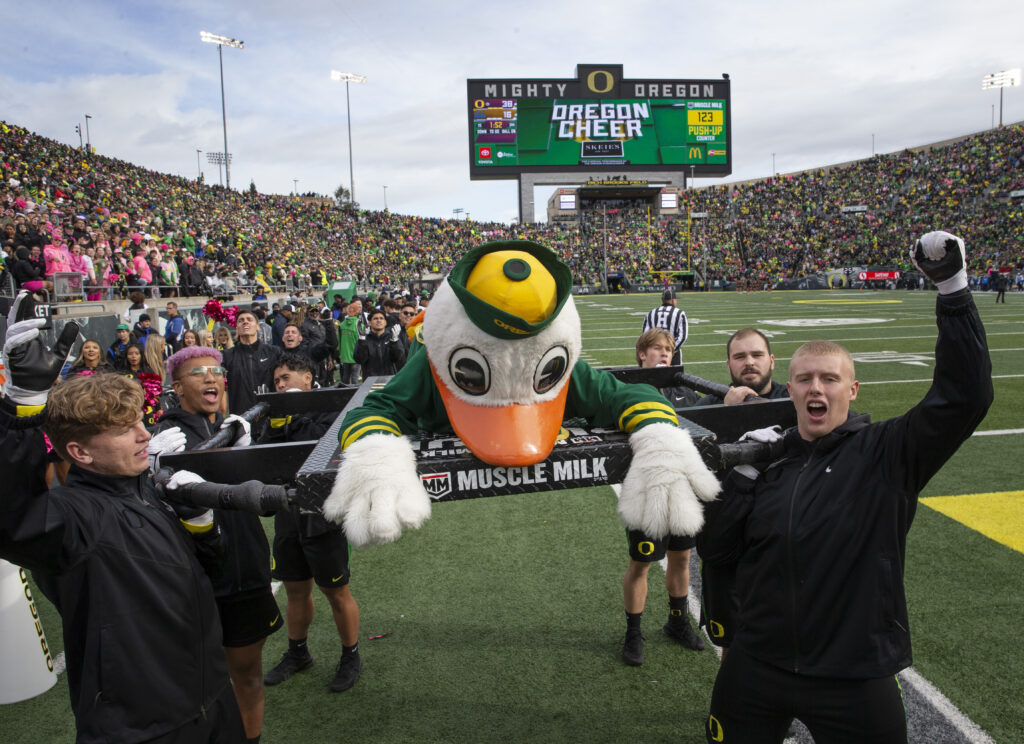INDIANAPOLIS — The Duck is everywhere this summer, and so are the Ducks.
While Oregon’s mascot takes stock of Big Ten campuses, the football program stands as a fixture in national championship conversations.
The Ducks were No. 3 in the Coaches’ preseason poll released last week and are No. 2 in ESPN’s power ratings. Their national title odds (courtesy of FanDuel) are lower than any team not named Georgia or Ohio State. Their quarterback is the betting favorite for the Heisman Trophy.
The hype seems justified: Coach Dan Lanning’s roster is stocked with returnees from a team that won 12 games last season and narrowly missed the College Football Playoff.
But the lofty expectations for 2024 would not exist without a recruiting class for the ages.
Oregon’s class of freshmen and transfers features the highest percentage of blue-chip prospects in school history (during a normal recruiting cycle) and stands as one of the greatest collections of talent for a West Coast program since the recruiting services began rating prospects.
The Ducks signed 41 players during the 2023-24 recruiting cycle, according to the 247Sports database, with 25 players carrying four- or five-star ratings.
That blue-chip percentage of 60.9 has been exceeded only once in Eugene, in the winter of 2020-21, when the recruiting calendar was completely uprooted by COVID, prospects were forced to pick schools without visiting campus and the Ducks topped out with a blue-chip percentage of 71.
“What Oregon signed in 2024, whether via the traditional high school recruiting route or through the transfer portal, was one of the most elite classes of players you’ll see in the region,” said 247Sports national recruiting editor Brandon Huffman, who’s based in the Pacific Northwest.
“Five-star players from high school? Check. The No. 1 junior college player in California? Check. The No. 2 transfer class in the country, including two of the top 10 transfers overall? Check.”
The class has everything, starting with the most coveted quarterback on the transfer market, Dillon Gabriel, a sixth-year senior who spent three seasons at UCF and two at Oklahoma and is the preseason Heisman favorite.
Notably, Gabriel doesn’t carry a five-star rating from 247Sports. He’s one of the 22 four-star prospects underpinning Oregon’s recruiting class.
The five-star players are receiver Evan Stewart, a transfer from Texas A&M, and two high school signees, edge rusher Elijah Rushing from Tucson and receiver Gatlin Bair from Idaho, who is serving a church mission and will join the Ducks in 2026.
For comparison, Oregon’s 2016 recruiting class, which included Justin Herbert, had a blue-chip percentage of just 28.5. And the 2011 class, with quarterback Marcus Mariota, carried a blue-chip rate of 39.1 percent.
“It’s never one thing,” Lanning told the Hotline last month at Big Ten football media days. “But after Year 1, we were able to sit back and point and say, ‘This is what we did,’ and then after Year 2, it was, ‘This is what we were able to accomplish. Would you want to be a part of that?’
“The product we were able to put on the field, combined with the experience they have, has really created a narrative for guys joining our program.
“Good players want to play with good players. And we were fortunate that enough guys wanted to play with each other.”
The creation of the transfer portal and changes to NCAA rules governing class size and immediate eligibility make comparisons with pre-COVID recruiting difficult, particularly in terms of the quantity of blue-chip prospects signed by a given school.
But by percentages, Oregon’s class stands with some of the best on the West Coast in recent decades.
USC’s epic 2003 class, which featured Reggie Bush, LenDale White, Matt Kalil and Sedrick Ellis, had a blue-chip percentage of 42.8.
Washington’s 2014 class, which included Budda Baker, Dante Pettis, Greg Gaines and a barrage of players who helped the Huskies reach three consecutive New Year’s Six games, had a blue-chip percentage of just 16.6.
“For us, it’s a big process,” Lanning said. “It’s creating an entire experience for them in recruiting.
“First, it’s making sure these guys fit us. Then, it’s having the opportunity to say, ‘What’s our sell to make sure that guy comes and checks out our program?’ Before they come on campus, it’s creating a narrative for them, almost a preview before a movie: ‘Hey, this is what it looks like when you get here.’
“And then when they get here, it’s making sure the experience is better than anywhere else they go.
“Lastly, the product you put on the field, your seasons, are going to speak to the success you can have and what you can create.”
Oregon’s move into the Big Ten this season bolstered Lanning’s sales strategy. So, too, did the Ducks’ stellar NIL (name, image and likeness) game.
With support from Nike founder Phil Knight and former company executives, Oregon possesses one of the nation’s best-funded and organized NIL operations, allowing the Ducks to compete with blue-blood programs for blue-chip recruits.
Earlier this year, Nebraska athletic director Troy Dannen reportedly told a group of Cornhusker donors that Oregon spent $23 million on NIL compensation, comparable to Ohio State’s budget.
Although Dannen is familiar with the Eugene recruiting machine — he spent six months running Washington’s athletic department — the specifics of Oregon’s NIL budget haven’t been confirmed publicly.
“Do we have a lot more than everybody else? I think that’d be an exaggeration or we’d never lose,” Lanning told ESPN last month.
The Ducks haven’t lost often under Lanning, compiling a 22-5 record in his two seasons. But they are 0-3 against Washington and do not have a CFP berth.
That should change this fall as the playoff expands to 12 teams, with seven at-large slots available. Oregon’s roster has more than enough experience and talent to navigate the Big Ten gauntlet and non-conference dates with Idaho, Boise State and Oregon State.
Several newcomers are expected to start, including Stewart, defensive lineman Jamaree Caldwell (Houston), safety Kobe Savage (Kansas State) and Jabbar Muhammad (Washington), plus Gabriel, who threw 30 touchdowns for Oklahoma last season.
The freshman class features blue-chip prospects from eight states and provides vital depth, especially along the defensive front — a position group that has traditionally proven difficult for West Coast teams to stock with national championship-caliber talent.
The Ducks signed “a generational defensive line class of Western prospects,” according to Huffman, the 247Sports analyst. Led by Rushing, the No. 3-ranked edge rusher in the country, it includes six blue-chip talents (four freshmen and two transfers).
“Lanning has reached his goal of making Oregon an SEC-like program in recruiting,” Huffman said. “Now he wants to add SEC hardware” — a national championship trophy — “to the mix. The Ducks have the stars.
“They just need to get them to align.”
*** Send suggestions, comments and tips (confidentiality guaranteed) to pac12hotline@bayareanewsgroup.
*** Follow me on Twitter/X: @WilnerHotline
Related posts:
 Pac-12 survival guide: Five reasons San Diego State is the obvious expansion option
Pac-12 survival guide: Five reasons San Diego State is the obvious expansion option
 Pac-12 football preview: Our picks for the conference race, with projected records, analysis and a title game projection
Pac-12 football preview: Our picks for the conference race, with projected records, analysis and a title game projection
 Mailbag: Pac-12 vs. Big 12, ESPN vs. Amazon, UCLA vs. UC Regents and loads more
Mailbag: Pac-12 vs. Big 12, ESPN vs. Amazon, UCLA vs. UC Regents and loads more

(AP Photo/Aaron Doster)
College basketball 2024-25 preview: Alabama, Gonzaga, Kansas, UConn lead our preseason men’s Top 25Jon Wilner
Jon Wilner has been covering college sports for decades and is an AP top-25 football and basketball voter as well as a Heisman Trophy voter. He was named Beat Writer of the Year in 2013 by the Football Writers Association of America for his coverage of the Pac-12, won first place for feature writing in 2016 in the Associated Press Sports Editors writing contest and is a five-time APSE honoree.
